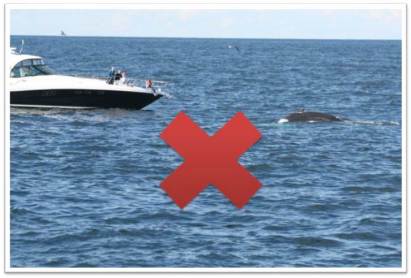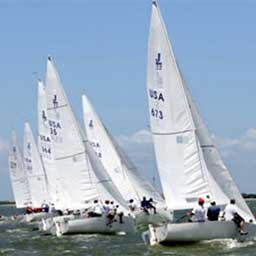How to Anchor a Sailboat
In this video, Kevin Wensley, Offshore Sailing School Director of Operations, shows you how to properly anchor a big cruising boat.
Using a Windlass
In this video, Kevin Wensley, Offshore Sailing School Director of Operations, explains how to properly use a windlass when bringing up the anchor.
Content provided by Offshore Sailing School on OffshoreSailing.com
Top 10 Reasons to Sail a Catamaran
- Fast is fun. Multihulls are fast. Average upwind speeds near 10 knots are common, and downwind at 15-20 knots is easy.
- Stability is relaxing. The ability to park and “chillax” is a great trait of multihulls.
- Fewer collisions. Because the collisions have high consequences there are very few.
- Kinetics don’t work. Sick of cheaters rocking and pumping? Those don’t work in multihulls, so the racing is better.
- Physically demanding. The loads are high so you get stronger.
- Mentally demanding. It’s all the same, and yet totally different.
- Mature fleet. Not old, but really cool. A little eccentric, very professional, and always interesting. Interesting boats attract interesting people.
- Cutting edge. Will you ever forget the first time you saw an AC 72 on foils?! The Americas Cup brings intense technological development.
- Globetrotting. The fastest way to cross an ocean or take a lap around the world is on a multihull.
- Fast is fun!
Contact Leandro Spina or Richard Feeny for more information. spinaleandro@gmail.com or richard.feeny@gmail.com
Bareboat Cruising: Weather and the Sailing Environment
Before you leave the charter dock, check the weather prediction for the next few days. Local weather stations will carry up-to-date information. Rapid and/or large barometric pressure movements usually indicate major changes in the weather.
East Coast
East Coast weather patterns change constantly as the continental land mass reconfigures passing weather fronts. Cool Canadian highs mix with warm, moist air from the south to create towering cumulus clouds which can become thunderstorms in the warmer months. Cold fronts move unpredictably but are usually followed by puffy and shifty northwesterlies. Early summer fog is common along New England’s shores, particularly in the warm days of May and June.
West Coast
West Coast weather forms over the Pacific Ocean. Winter storms track across the ocean and bring rain. From April through October, a huge, relatively stationary offshore high-pressure system, called the Pacific High, provides sunny weather and steady westerly breezes. Coastal areas experience regular sea breezes as the land heats up and the air flows from the sea to the land. Those areas adjacent to warm inland valleys frequently experience very strong afternoon winds and fog during the summer. Strong westerlies sometimes counter tidal currents and create unusually short and choppy waves such as can be found on San Francisco Bay. Winter cold fronts over the desert cause strong easterlies, called Santa Anas, which can extend many miles offshore in Southern California.
Island Weather
In the tropics, where large land masses are scarce, trade winds predominate. Usually lighter in the morning, these winds peak at around 20 knots in the evening. Puffy, flat-bottomed clouds scud across the brilliant blue sky. Close to the equator, the Inter-Tropical Convergence Zone (ITCZ) features light winds, squalls, and warm, overcast weather. The Caribbean’s easterly Christmas winds may bring some wind velocities up to 30 knots. Spring features lighter breezes and dry weather.
*For the best cruising instruction like this, purchase Bareboat Cruising on the US Sailing Store.
Dos and Don’ts of Planning and Cruise
An integral part, and part of the fun, of any cruise, is planning for it. Preparing for a bareboat charter includes a number of responsibilities to consider.
Here is a list of “Dos and Don’ts” of planning for your cruise.
- Do make travel arrangements well in advance.
- Do leave some extra time in your itinerary and dollars in your budget.
- Do use up-to-date charts and guides when making your plans.
- Do note stopover points where you can refresh supplies, including food and water, or pump out the holding tank.
- Do make backup plans for adverse wind and weather conditions.
- Do make sure everyone knows beforehand about medical conditions that may exist among the crew and the procedures for handling any situations that may arise.
- Don’t over-plan.
* For more cruising resources like this, purchase Bareboat Cruising on the US Sailing Store.
Cruising Crew Overboard Prevention: How to Remain Aboard
Following these rules can prevent virtually all man-overboard incidents:
- Remain sober, especially if you expect to go on deck for any reason.
- Wear non-skid footwear when working on deck and have nonskid paint or pads in critical work areas.
- Walk or crawl on the uphill windward side in a crouched position with a low center of gravity and wide-based stance when the boat is rolling, heeling, or pitching.
- If the boat’s motion is too violent to allow a person to stand, then crawl or slide along the deck.
- Use a safety harness (with two shackles) as a “third hand,” secured to a strong attachment point, with a quick release shackle at the body end of the harness.
- Use a safety harness whenever going aloft in the rigging or climbing any superstructure.
- Avoid leaning overboard with all your weight on a lifeline or stanchion.
- Know the location of secure handholds and grab rails so you can find them at night.
- Know the safe routes to avoid tripping on deck hardware, vents, and hatches, especially at night.
- Do not urinate from the afterdeck in rough weather unless you are kneeling and attached to a safety harness.
- Wear a safety harness whenever seasick; vomit into a bucket rather than leaning overboard.
- In heavy weather, sleep in the harness and be ready to attach the tether to a cockpit.
Paul Auerbach, Wilderness Medicine, Chapter 83, “Safety and Survival at Sea,” by Michael E. Jacobs and Charles Hawley.
Cited in US Sailing Safety at Sea, Chapter 9 – Crew Overboard Prevention and Recovery by Peter Isler. Learn more about Crew Overboard Prevention and Rescue.
Weather Forecasting: Thunderstorms and Squalls
by Stan Honey and Ken Campbell
There are three types of squalls/thunderstorms: those associated with a cold front or low-pressure area, the “air mass” thunderstorm, and trade wind squalls. Cold front thunderstorms develop along the leading edge of a cold front. Remember, the cold front brings a wind shift from the south or southwest into the west and northwest. The cold front also brings a change in temperature and increased dryness of the air.
Thunderstorms develop vertically into the atmosphere, reaching heights of 40,000-50,000 feet. The rule of thumb is the taller the thunderstorm, the more violent the weather will be. Taller, more violent thunderstorms will be preceded by an area of high clouds that spread out from the top of the thunderstorm, moving with the jet stream. Since these higher clouds appear overhead before the thunderstorms arrive in your area, they will give you an early warning signal of an approaching squall line.When thunderstorms develop up into the jet stream level – which moves faster than the cold front – they will move out in front of the cold front.
Thunderstorms can precede the cold front by several hours. If this happens, there will be a weather lull between the squall line and actual cold front. But if the lull lasts for more than three to four hours, there could be a second squall line closer to the actual cold front.Air mass thunderstorms form inland during the afternoon and move very little. During late afternoon and evening, when the afternoon sea breeze weakens and ends, thunderstorms will move towards the shoreline. If the thunderstorms persist long enough, they can bring squally weather to the coast around and after sunset. The Florida coast, parts of the Central American coast, Africa, and Brazil are notorious for the late afternoon and evening squally thunderstorms, especially during the summer seasons.Trade wind squalls are typically smaller, less developed, and less violent than thunderstorms.
A simple rule of thumb is: the taller the cloud, the stronger the squall will be. They generally move from east to west in both hemispheres. They are strongest two to three hours before sunrise. They are weakest from late morning thru mid-afternoon. Mid-morning showers can cause very large areas with very little wind. Squalls that form around or just after sunset can also be gusty.This resource is provided by the US Sailing Safety at Sea Committee.
Learn more about US Sailing Safety at Sea Seminars in your area.



















